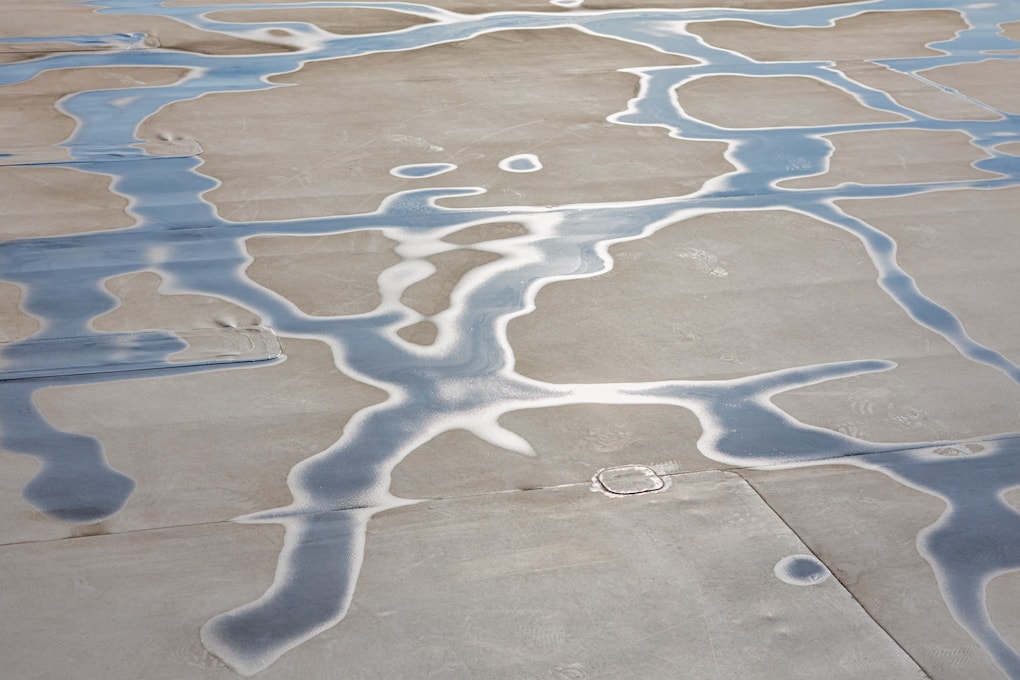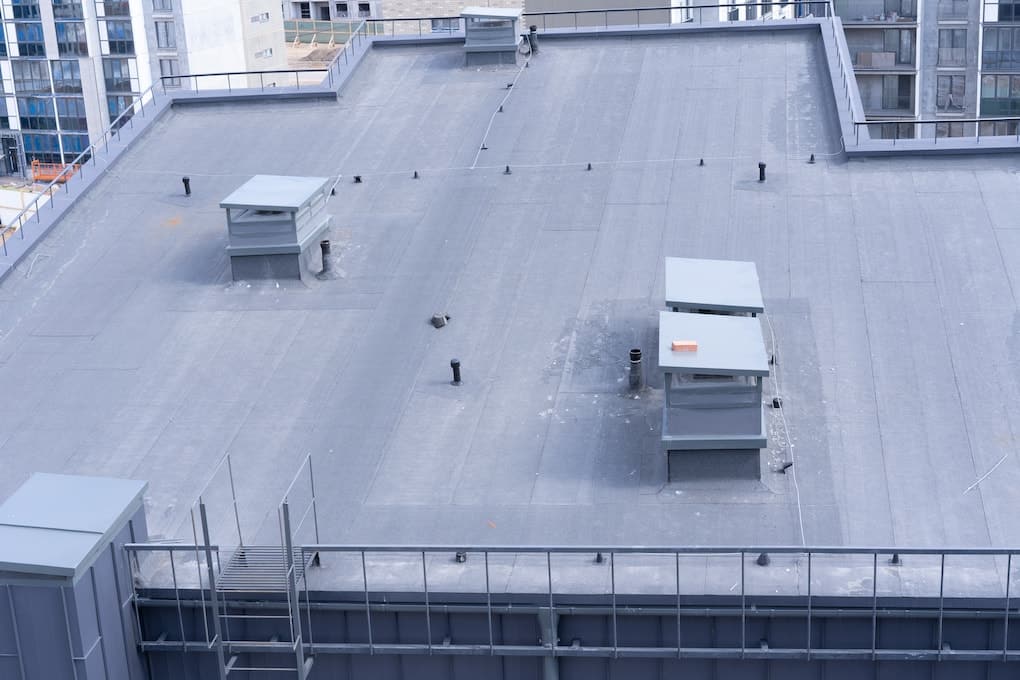A built-up roof is one of the most commonly used roofing systems for flat or low-slope roofs, primarily in commercial roofing. The name comes from its multi-layered design that is “built up” to create seamless, waterproof protection for your roof. Many components make up this type of flat roof, and many benefits showcase why it’s a good choice for your home or business. Today, we’ll talk all about BURs, their pros and cons, and help you make an informed decision to install one!
What is a BUR?
Built-up roofing systems, or BUR, are a common type of flat roofing material. It’s literally built up using multiple layers of bitumen, felt, asphalt, and other materials to create the final result. They are relatively quick and easy to install and are applied layer by layer. BURs are also one of the oldest forms of flat roofs, having been used for over 100 years. They’ve changed and morphed into what they are today, but continue to stand the test of time as one of the most effective materials to use for a flat roof.
What are BURs Good For?
A built-up roof is great if you’re looking for low-slope roofs with heavy traffic (like commercial buildings) because it provides an easy installation process while still creating long-lasting protection from harsh conditions like wind and rain. Additionally, they provide excellent durability so the investment will last through many years’ worth of wear and tear. There’s not a one-size-fits-all version of a built-up roof, and they can have many layers of many materials, but here’s a basic example of the layers included in a standard BUR:
Insulated Layer
On top of the roof decking and sheathing is the roof insulation. This thick layer of rigid foam insulation ensures the roof sheathing underneath stays warm and dry, properly insulating your building. Installing the roof insulation underneath the roof sheathing works less efficiently.
Asphalt
A BUR might use coal tar or cold-applied adhesive as the first layer, but more often than not, asphalt is the best option. Asphalt is heated up and applied via mop or another type of spreader that lays it flat and even across the roofing surface.
Cover Board
The cover board is usually made of a lightweight, built-up composite designed to provide extra durability under the asphalt layer. It is the base sheet to add protection for your built-up roof, and will help with water resistance and longevity; plus, it creates a flat surface to start building up your layers of asphalt and ply sheets.
Asphalt & Ply Sheets
Another layer of hot asphalt is laid down, followed by a single-ply sheet, another layer of asphalt, another ply sheet, and so on until there are three to four layers of each. These alternating layers are key to ensuring that your roof is impervious to strong winds, heavy rain, and high or low temperatures.
Reflective Roof Coating
This layer is essential to providing more energy efficiency with ultraviolet protection. Most commercial roofs today consist of a top layer that is highly reflective of the sun’s UV rays which keeps your roof cooler and energy bills lower.
Gravel
Lastly, a layer of gravel is applied to the built-up roof, usually around an inch or so thick, depending on your preference. The final goal with this top layer is to provide the first layer of protection from water penetration and damage from debris. In addition, gravel alleviates the heavy blow of severe weather or high winds, and protects the layers below, helping them last longer and require fewer repairs.
Pros of Built-Up Roofing
A built-up roof is useful because it can be applied on many different surfaces, and provides excellent waterproofing that’s perfect for a flat or low-slope roof. They also offer protection from the elements such as wind or rain because they are constructed with very heavy materials. This means you won’t have to worry as much about repairs down the road, thanks to their durability.

Excellent Weather-Proofing
The multi-layered design of a built-up roof ensures your roof can withstand even the harshest weather. The asphalt and bitumen are thick enough to protect your roof from debris impacts and watertight to ensure no water can seep through as long as it’s well installed and maintained.
High UV Protection
The reflective coating on top will protect your roof from the harsh UV rays that can both heat up your roof, causing your HVAC to work harder, and also keeps the UV rays from wearing down materials quickly.
Fire-Resistant
Tar is super flame-resistant because it takes an incredibly high amount of heat to ignite it. So you can rest easy knowing, should a fire ever happen on your roof, it will have some protection against fire spreading quickly to your building.
Low-Maintenance
There is very minimal upkeep for a built-up roof. You can expect your built-up roof to last anywhere from 20 to 40 years when properly installed and with little maintenance. You want to make sure to inspect it for any damage, cracks, or pooling water every year. Small repairs may be required throughout its lifetime, but it won’t need a full replacement for many years.
Affordable to Install and Maintain
Built-up roofs are one of the more cost-effective flat roofing materials. Many factors affect how much it might cost, and it can vary greatly based on the size of the roof, materials used, location, and the contractors you hire. Prices can range anywhere from $250 a square to $800, which still makes it one of the most cost-effective materials, especially considering its lengthy lifespan.
Cons of Built-Up Roofing
Despite its affordability and longevity, built-up roofing still has its fair share of downsides, mostly due to general wear and tear or incidents of storm damage.
Cracks
One of the most common built-up roof issues is damage from freeze-thaw cycles. Cracks in your BUR can lead to leaks that will need prompt repair or replacement, so it’s important you have a good warranty on workmanship before starting any job.
Water Pooling
If your flat roof experiences high volumes of heavy rain and goes unchecked, it can lead to water pooling on your roof. Eventually, it seeps through and damages an adjoining building or weakens structural components in the built-up roof itself.

Blistering
Lastly, too much water damage paired with the hot sun can actually cause blisters in the top layer of your roof. The blisters make your built-up roof more susceptible to tearing, especially in high foot traffic areas. It can be dangerous and should be dealt with right away.
Most of the downfalls of a built-up roof can be avoided with proper installation, maintenance, and regular inspections. If your home or business needs an affordable roof that will last a long time, built-up roofing is a great option. To get started on your flat roof installation, contact Apple Roofing today!

